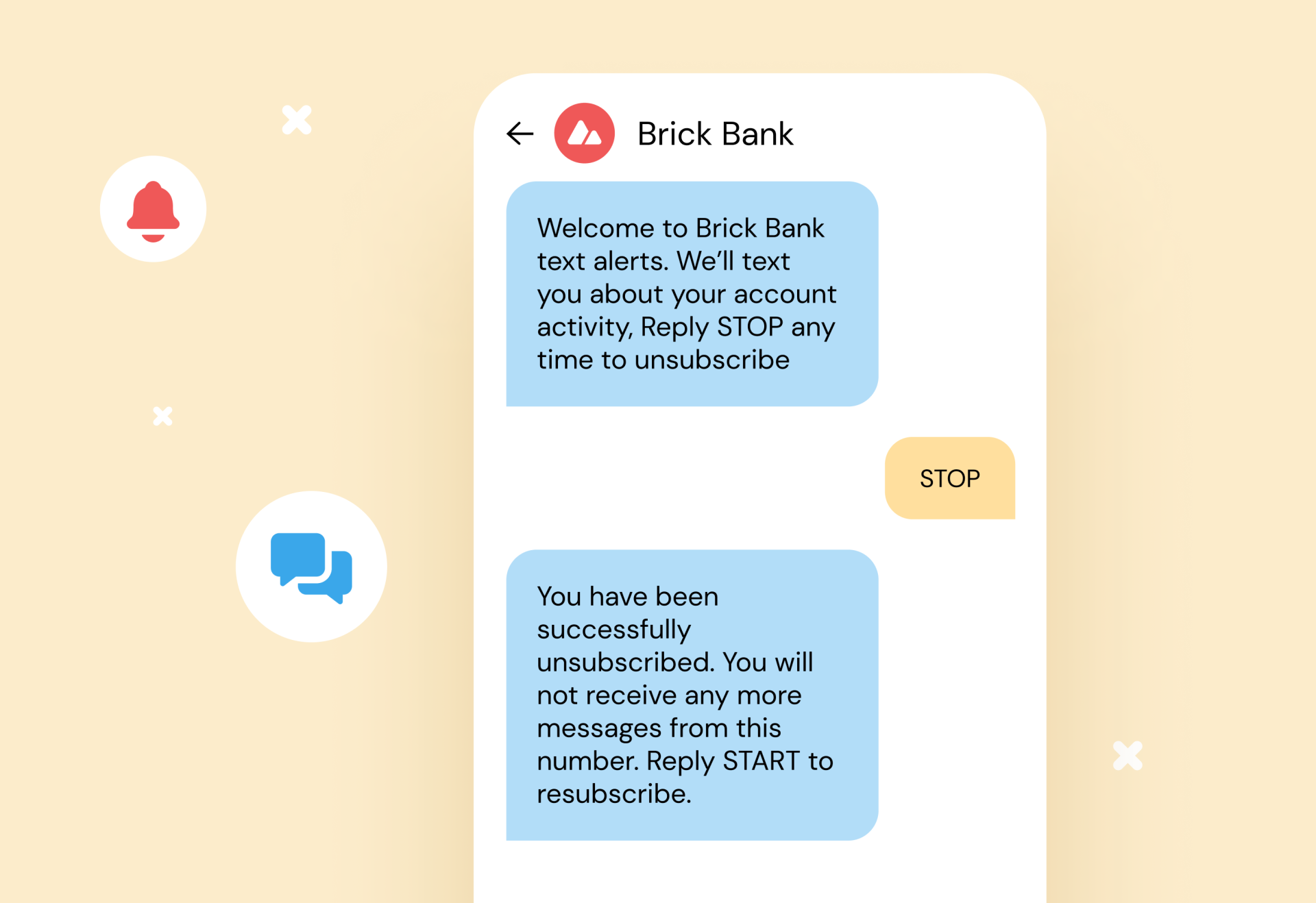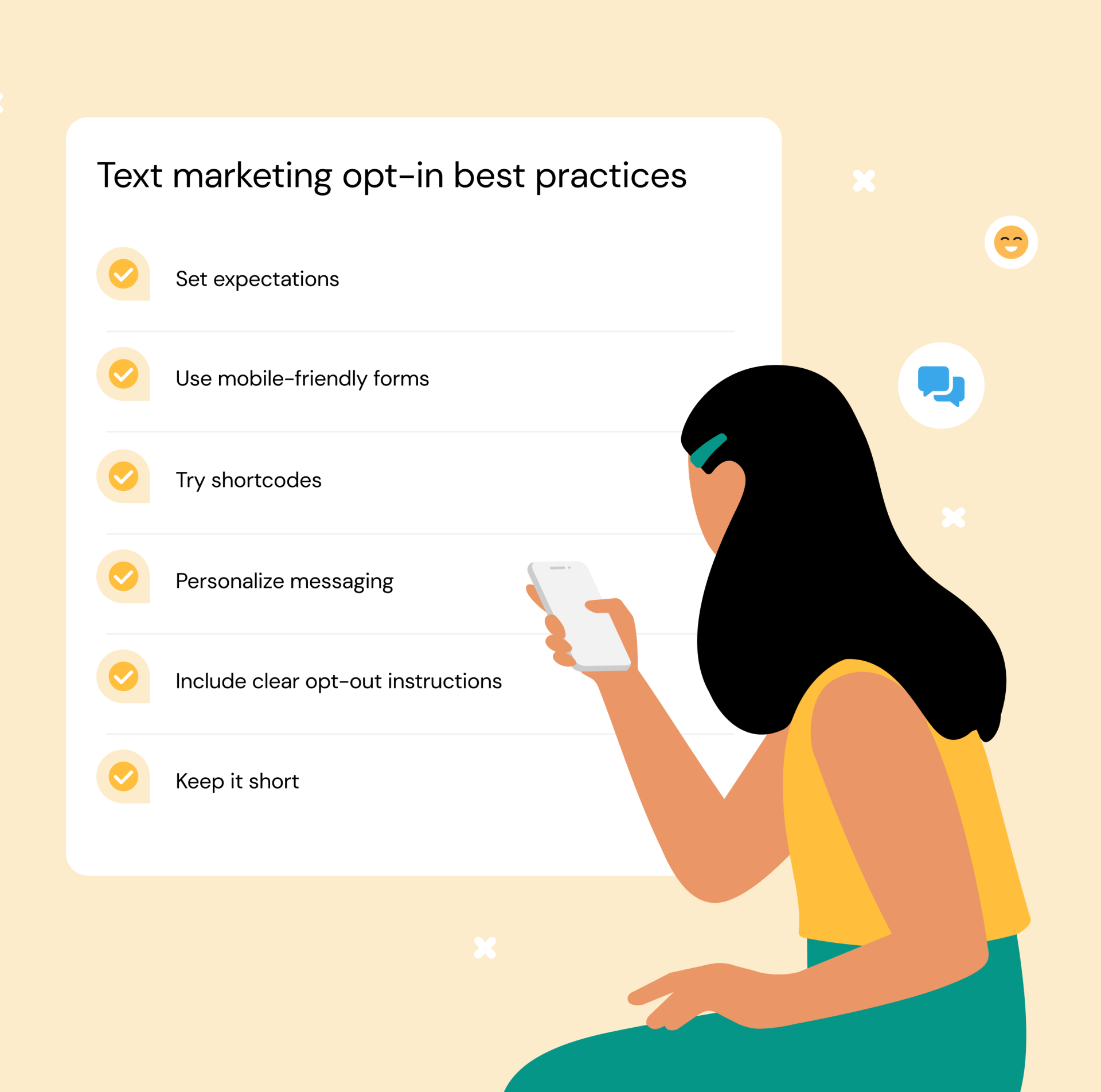Insights
What is SMS opt-in? Examples and best practices for growing your list

Insights

No marketing channel drives faster or bigger responses than SMS marketing – it’s not even close. The companies that have figured out how to use SMS to deepen customer loyalty and grow their revenue are reaping the benefits. And it all begins with building an SMS list and then growing it with ongoing SMS opt-in campaigns.
But how hard is it to set up SMS marketing infrastructure? What are the costs, the challenges, and how do you navigate compliance regulations?
As you’re about to see, getting started with opt-in text messaging is easier than you might think.
And the payoff can be immense. Because texts are so short, and because most people carry their phones all the time and get notified when a text has arrived, they’ve been trained to open and read SMS messages as they come in. And most people do. The open rate for SMS messages is about 98%, and 60% of them get read within five minutes of being sent. That level of immediate engagement of over half your SMS list surpasses every other marketing channel – by far. Smartphone users are 4.5 times more likely to respond to a text than an email.
If you want to increase revenue and engage your customers in places where they’ll see and respond to your marketing communications, start by growing your SMS list. That begins with creating an opt-in campaign.
In this article, we’re going to look at how to get more SMS opt-ins so you can grow your list and use this highly effective and low-cost marketing channel to achieve more of your overall marketing goals.
An opt-in SMS is a text message where a consumer joins a business’ SMS list and gives them permission to send marketing messages, alerts, and reminders via text message.
There are three types of SMS opt-in procedures – single opt-in, double opt-in, and soft opt-in. Here’s a brief summary of each:
Double opt-in is considered best practice for adding new subscribers to your SMS list because it weeds out spammers and bots while also assuring you this person really wants to join your list. This matters because SMS regulations in most countries require written permission from consumers that they want to receive your SMS marketing campaigns. The double opt-in removes all doubt that this person agreed to join your list.
How does double opt-in work? Here’s how a customer might experience it:

An opt-out message gets sent from the subscriber to the business when they no longer want to receive marketing or promotional messages. If you’re on any SMS lists of other companies, you already know how this works. You simply add a short message at the end of each text saying that they can text STOP if they want to stop receiving SMS messages from your company.
Subscribers can send a variety of texts to express their desire to opt out. And even though you might tell them how to opt out, they may not do so exactly according to your process. Sometimes this happens by simple misspellings.
For example, your text may instruct them to text STOP if they want to unsubscribe, but they might text STIP, or S T O P with spaces or dashes, or other common variations like S TOP, S t op, sstop, and sTOP. Some users even text the word SPAM, even though your messages aren’t spam.
But in all these cases, the intent of the message is clear, and you are supposed to acknowledge and act on that request and remove them from your SMS list.
In the U.S., businesses are required by carriers that at least one message per month contains STOP information for users to have the option of opting out of receiving further messages. To do this, simply add a short message at the end of your message telling subscribers to text STOP to unsubscribe.
To be clear, offering an SMS opt-out option is a requirement in many countries. So this isn’t something you can just leave out.

Having an SMS marketing list is a huge business asset. But it’s very important that the people on your list have signaled that they want to be there, because SMS compliance is very strict.
Sending unsolicited text messages can lead to big fines. This is partly because mobile carriers don’t want their networks clogged with spam. Plus, an SMS inbox is a personal place, and customers don’t want spam there, either.
Using proper SMS opt-in procedures, and making it easy to opt out, will help you build trust with those on your subscriber list, give them a good customer experience, and help build long-lasting, profitable relationships that benefit customers and drive revenue for you.
We are not lawyers (and this isn’t legal advice), so you should consult with your own legal team or counsel before starting any new marketing program. This is important because in the U.S., SMS communications are governed by the Telephone Consumer Protection Act (TCPA), which dates all the way back to 1991. Other guidelines come from the Cellular Telephone Industries Association (CTIA) and the Federal Communications Commission (FCC).
Before we look at some specifics, it’s important to understand that the rules in countries like the United States are different for transactional SMS and promotional SMS.
Transactional SMS refers to automated messages like appointment reminders, password resets, and purchase receipts. They’re sent in response to a specific action taken by the customer, and there is no expectation or agreement that any other messages should be sent afterward.
Promotional SMS messages cover almost everything else – the marketing campaigns, flash sales, special offers, content marketing, and other messages intending to engage your subscribers.
For transactional SMS messages, the consumer still needs to give permission, but they do so with the understanding that they will not receive marketing and promotional texts. They can give consent for transactional messages over text, with an online form, or even verbally. And consenting to receive a transactional text does not imply consent to receive promotional texts.
For promotional SMS consent, consumers must give explicit written permission before they receive any promotional texts. “Written” can include digital methods like signing a form or clicking a checkbox online.
Here are some additional regulations regarding promotional SMS:
It is required to obtain explicit written consent from a new subscriber that they want to receive promotional texts from your company. Be sure to keep accurate and updated records of when and how consent was given.
Again, you must remind consumers at least once per month that they can revoke their consent. Here’s a complete list of SMS opt-in best practices from CTIA.
Some content is strictly prohibited for distribution over SMS channels, or is subject to special rules. The SHAFT acronym helps you remember the type of content that’s restricted:
The TCPA also stipulates that your SMS opt-in form must clearly state a few pieces of information:
Additionally, if you’re using 10DLC messaging to send SMS, you’ll need to make sure you’re following all the right steps to ensure your brand is registered to send A2P 10DLC.
How often should you send marketing texts? Again, SMS isn’t like email. People don’t want to be texted every day. Even a few times per week is pushing it. Once a week, or a couple times a month, is a safer pace for SMS, excluding things like automated reminders and confirmations.
All that should be in your form, and you should also include this information again in your welcome text.
Remember that with SMS, many people use audible notifications on their phones to inform them when a text message arrives. So take note of the time zones of your SMS subscribers and avoid sending messages too late at night or too early in the morning.
Before getting started with your SMS marketing plans, check with local regulations, business policies, and your legal team, just to be sure you aren’t ignoring any SMS requirements. For U.S. companies, see our SMS compliance guide for information about privacy laws, carrier expectations, and more.
How you grow your opt-in SMS list will vary based on context. If you have in-store clerks talking about your store’s promotional SMS campaign with customers as they pay for items, that clerk probably isn’t going to go through all the legal requirements listed above. That’s one reason to put it all in your welcome text.
But you might want to create a small brochure that has all that information too, if you have brick-and-mortar locations.
For other businesses, whenever you market your SMS list, try to do all of the following as part of your opt-in process.
This is the fun part. Clearly communicate the benefits of opting in to your SMS list. They’ll get updates, insider information, special offers, and they will be the first to know when something new and exciting is happening. And as mentioned earlier, tell them about how often you’ll send messages, and that opting out is super easy.
Text messages are limited to 160 characters, unless you use MMS as opposed to SMS. So don’t beat around the bush. State the offer. Give the call to action (CTA) and a link or other method of response, and that’s it. It also helps to insert personalized information using dynamic fields, and to personalize by sending texts to segments of your subscribers and customers. The webpage your CTA links to can provide all the other information regarding your marketing campaign.
Shortcodes are five-digit numbers (sometimes six) that companies use to make it easy for subscribers to respond to offers. For example, “text SANTA to 44444 to claim your holiday discount,” or “text WIN to 33333 to enter the contest.” You can also use codes to make it easy to join your SMS list in the first place – “text JOIN to 55555 to receive texts from us.”
Email is a great place to promote your SMS list because your subscribers already know you and consent to marketing messages. You can use your website and promote it on your home page, banners, popups and within page content. You can also use social media channels, in-store displays, print marketing, as well as channels like TV, streaming, and content marketing.
One of the best places to promote your SMS is on your checkout and thank you pages. Those moments are when customers feel their most positive feelings about your company. So why not offer them a chance to stay in touch via SMS?
Just like with email, you can insert personalized information in texts using dynamic fields. You should look to do this as often as appropriate. If you’re sending a campaign to a particular region, city, or state, you might be able to fit that into your SMS copy. You can also add names, companies, past purchase dates, and lots of other personalized information.
People like feeling known and being treated special, and personalized marketing is a great way to do this with SMS!
You can also personalize by list segment (similar to what you might do with email segmentation). You may have some subscribers who are interested in certain products or services, and others who prefer different ones. By segmenting your list, you can speak to each subscriber with more relevance to their lives and interests.
No matter where you’re promoting your SMS list, text-to-join keywords make it much easier to subscribe to your SMS list. And the more fun you make these words, the better. Instead of “text JOIN to receive text messages from us,” say something like “text SURPRISE to claim your discount!” The more creative and unique the SMS keyword is to your brand, the more fun and memorable it will be for new subscribers.
This is the most effective approach to motivating people to join your SMS list. Offer them a special discount, free gift, coupon, or other sort of immediate benefit to joining. To decrease opt-outs and motivate people to remain on your list longer, your incentives could include annual specials, rewards points accrual bonuses, and other repeating or accumulating benefits. This is why SMS marketing is ideal for people who already know, like, and trust your brand.

Want to see some examples and templates of how your initial text messaging campaigns can look? Here are ways you can tailor your SMS to different situations and audiences, from Black Friday to loyalty programs.
Remember that you must get express written consent to text your contacts. This means gaining an initial opt-in through a digital or physical form and confirming that choice via text.
Here, we’ll give you some SMS opt-in message examples for different use cases, followed by promotional examples you could follow up with after someone has confirmed. These are only general examples meant to inspire you, so for advice specific to your business we encourage you to reach out to a legal professional!
Big sales are the perfect time to use your SMS list and drive customers to your store. Even with its 160-character limit, SMS allows you to deliver a full marketing message effectively.
For instance, if you’re running an SMS opt-in campaign as a retailer, you could ask them to opt-in by texting a shortcode. Remember the information your opt-in CTA must have information clear up front, like the types of messages someone can expect to receive, how frequently they’ll come, possible message rates, and terms and conditions. Then, you could double confirm their subscription with a message like this:
Once they reply “YES,” you can send them this message:
Then, to promote your offer, you could send a message like this:
Note when you share your website, you should use your company’s actual domain name, and not a tinyurl or bit.ly link.
Say, for example, that you’re asking people to sign up for loyalty rewards after they’ve made a purchase. You could first have them consent to receive updates via SMS using a form with the requisite language.
Then, after they’ve clicked “subscribe,” here’s an example of an SMS opt-in message you could send to customers to double confirm that they want to opt in:
Once they reply “YES,” follow up with a confirmation message:
Then, to promote a reward, you could send a message like this:
For customer support text messages, brands often prompt customers to text them first or sign up for specific updates on their website. Remember to have requisite language and a link to your privacy policy in the opt-in form.
Here’s an SMS opt-in message that you could send someone after they’ve checked the requisite box on your website to receive help from an SMS chatbot for customer support.
Clearly, it’s easy enough to start with an SMS opt-in campaign if you have the right language and processes!
SMS marketing offers a way to communicate directly with customers who have already said they want to hear from you, and it has no spam folder. Nearly all your SMS subscribers will see and open your promotional and transactional text messages. You can also use SMS automation, just like you do with email marketing.
The sky-high open and response rates of SMS lead to higher revenue and more customer loyalty. With an SMS program added to your other marketing efforts, your conversion rates and revenue will increase. And by respecting your customers’ communication preferences, you will build trust with your subscribers, resulting in long-lasting customer relationships.
One of the key components of getting ready to send SMS campaigns is through an SMS API. For that, you need to choose an SMS provider like Sinch. Find out what makes Sinch’s SMS API so powerful and unique for companies like yours.